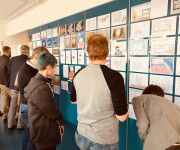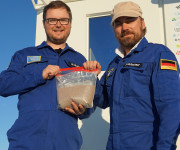NASA seeds germinate in DLR’s EDEN ISS greenhouse
Start of a new series of tests for plant cultivation on the Moon and Mars
Nine weeks of darkness and temperatures down to minus 50 degrees Celsius. Under these harsh conditions of Antarctica, NASA and the German Aerospace Center (Deutsches Zentrum für Luft- und Raumfahrt; DLR) have begun a joint series of experiments on vegetable cultivation techniques for use on the Moon and Mars. Until early 2022, NASA guest scientist Jess Bunchek will research how future astronauts could grow lettuce, cucumbers, tomatoes, peppers and herbs, using as little time and energy as possible. To this end, she will be working at DLR’s EDEN ISS Antarctic greenhouse, where she will put greenhouse technologies and plant varieties to the test. She is also recording any effects the greenhouse and its yield have on the isolated hibernation crew in the perpetual ice. Bunchek is part of the 10-person overwintering crew on Neumayer Station III, operated by the Alfred Wegener Institute, Helmholtz Centre for Polar and Marine Research (AWI).
First harvest – Lettuce, mustard greens, radishes and herbs
“The polar night will soon begin here on the Antarctic Ekström Ice Shelf. With the nine other members of the overwintering crew, it almost feels like we are alone on another planet,” says Bunchek. “In this hostile world it’s fascinating to see the greenery thrive without soil and under artificial light.” Bunchek is a botanist from the Kennedy Space Center, where she has primarily supported the VEGGIE project on the International Space Station (ISS) She was able to sow the first seeds in recent weeks, following a technical reconditioning of the EDEN ISS platform conducted by her and the DLR team. The first harvest, which included lettuce, mustard greens, radishes and various herbs, followed a few days ago.
NASA seeds and new nutrient supply system
The EDEN ISS greenhouse uses particularly robust varieties that were selected by the EDEN ISS Project team and from experiments at NASA’s Kennedy Space Center and as part of the VEGGIE project on the ISS. The DLR/NASA mission also aims to record and compare the growth and yield of the crop varieties under the conditions of the Antarctic greenhouse. An additional focus will be studying which microbes thrive in the greenhouse alongside the cultivated plants.
NASA will also be testing a plant watering concept in the EDEN Module that can operate in u-gravity settings, like the ISS. The system contains the water and delivers it to the plants by a passive method. “This will provide a side-by-side comparison with the aeroponically grown plants of EDEN ISS” says Ray Wheeler, plant physiologist at NASA’s Kennedy Space Center. In aeroponic irrigation, the roots of the plants without soil are regularly sprayed with a nutrient solution.
Crew time – a precious commodity
Sowing, harvesting, tending, cleaning, maintaining, calibrating, repairing and conducting scientific activities. Bunchek records every second of her activities in the Antarctic greenhouse with a special time-recording eight-sided die, as crew time will be a precious commodity on future missions to the Moon and Mars. “In an initial test run of the greenhouse during the 2018 mission, we found that operations still took too much time,” explains EDEN ISS project leader Daniel Schubert from the DLR Institute of Space Systems in Bremen. “Now we are working on optimising processes and procedures. We have learned a lot about operating a greenhouse under extreme conditions. We’re applying all this during the current joint DLR/NASA mission.” In addition to the crew’s time, the focus is on their well-being. The overwinterers regularly answer questions about their eating habits or how the plants affect their mood. “We hope to increase our understanding of having plants and fresh food for crews in remote, isolated settings like Neumayer III and ultimately for space” says Wheeler.
On 19 January, Jess Bunchek reached the Antarctic continent on board the research vessel Polarstern. Since 19 March, the 10-person overwintering crew has been on their own at Neumayer Station III. “EDEN ISS is an asset for the crew in many ways,” says Tim Heitland, Medical Coordinator and Operations Manager at AWI. “I know from my own overwintering experience just how much you can begin to miss fresh produce. It’s not just about the taste, but also the smells, the colours and the fascinating fact that something can grow in this inhospitable environment. That’s why there are always volunteers in the overwintering teams to help cultivate and harvest the plants.” The polar night at Neumayer Station III begins on 21 May, and the first rays of sunlight will not reach the station again until 23 July. Researchers for the summer season and new supplies will end the isolation of this year’s overwintering crew around the beginning of November.
The activities at the EDEN ISS Antarctic greenhouse can be followed on social media using the hashtag #MadeInAntarctica. The Antarctic greenhouse has Facebook and Instagram accounts, as well as a flickr image gallery. Jess Bunchek also writes about her personal experiences of the Antarctica mission in the dedicated DLR blog.











